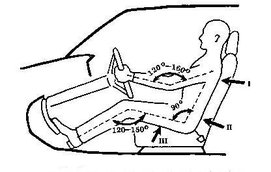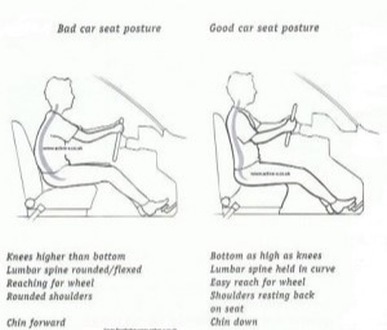Leg Room
Adjusting the position of your legs is vital in avoiding deep vein thrombosis. Don’t stay in cramped positions for long periods of time. Utilise service stations to walk around and stretch out.
While driving:
• You should be able to operate the pedals without your legs being scrunched up or your back coming away from the seat, pushing the pedals all the way down using just your foot with your thigh relaxed.
• Your knees should be very slightly bent and you should feel no discomfort when bringing your foot upwards.
• Your legs and pelvis should be able to shift and move position to relieve pressure points and keep blood circulating without detracting from your driving.
Your Seat
One area of your seat adjustment that is regularly overlooked is the tilt of your seat.
Adjusting the driving position makes life much more comfortable:
• Tilt the seat so that your bottom and thighs are supported equally. You don’t want pressure points at the end of the seat and your thighs should extend past the seat so the backs of your knees are not making contact.
• Recline your seat up to a 100-110 degree angle to support the upper body and take away pressure from the muscles, joints and discs in your lower back.
• The height of your seat is very important to the comfort of your driving. Your hips and knees should be the same level and you should have a good view out of the front window without your knees touching the steering wheel.
• To minimise the strain on your neck and upper back, adjust your steering wheel so that your elbows do not reach too far forward.
You should vary the positions you drive and how you grip the steering wheel regularly to change the stressors on certain parts of your neck and back.
Your Mirrors
Be sure to stay in a safe driving position and alter your mirrors each time you adjust your seat.


